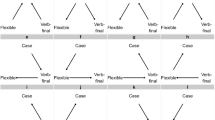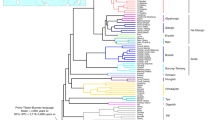Abstract
Languages, like molecules, document evolutionary history. Darwin1 observed that evolutionary change in languages greatly resembled the processes of biological evolution: inheritance from a common ancestor and convergent evolution operate in both. Despite many suggestions2,3,4, few attempts have been made to apply the phylogenetic methods used in biology to linguistic data. Here we report a parsimony analysis of a large language data set. We use this analysis to test competing hypotheses—the “express-train”5 and the “entangled-bank”6,7 models—for the colonization of the Pacific by Austronesian-speaking peoples. The parsimony analysis of a matrix of 77 Austronesian languages with 5,185 lexical items produced a single most-parsimonious tree. The express-train model was converted into an ordered geographical character and mapped onto the language tree. We found that the topology of the language tree was highly compatible with the express-train model.
This is a preview of subscription content, access via your institution
Access options
Subscribe to this journal
Receive 51 print issues and online access
$199.00 per year
only $3.90 per issue
Buy this article
- Purchase on Springer Link
- Instant access to full article PDF
Prices may be subject to local taxes which are calculated during checkout



Similar content being viewed by others
References
Darwin, C. The Descent of Man, and Selection in Relation to Sex (Oxford Univ. Press, Oxford, 1871).
Kirch, P. V. & Green, R. C. History, phylogeny, and evolution in Polynesia. Curr. Anthropol. 28, 431– 456 (1987).
Mace, R. & Pagel, M. The comparative method in anthropology. Curr. Anthropol. 35, 549– 564 (1994).
Ruvolo, M. in Biological Metaphor and Cladistic Classification: An Interdisciplinary Perspective (eds Hoenigswald, H. M. & Wiener, L. F.) 193– 216 (Univ. Pennsylvania Press, Pennsylvania, 1987).
Diamond, J. M. Express train to Polynesia. Nature 336, 307–308 (1988).
Terrell, J. History as a family tree, history as an entangled bank: Constructing images and interpretations of prehistory in the South Pacific. Antiquity 62, 642–657 ( 1988).
Terrell, J., Hunt, T. L. & Gosden, C. The dimensions of social life in the Pacific. Curr. Anthropol. 38, 155–195 (1997).
Hillis, D. M., Huelsenbeck, J. P. & Cunningham, C. W. Application and accuracy of molecular phylogenies. Science 264, 671–676 (1994).
Crowley, T. An Introduction to Historical Linguistics 3rd edn (Oxford Univ. Press, Auckland, 1997).
Warnow, T. Mathematical approaches to comparative linguistics. Proc. Natl Acad. Sci. USA 94, 6585–6590 (1997).
Bateman, R. et al. Speaking of forked tongues. Curr. Anthropol. 31, 1–24 (1990).
Moore, J. H. Putting anthropology back together again: The ethnogenetic critique of cladistic theory. Am. Anthropol. 96, 925–948 (1994).
Bellwood, P. The Prehistory of the Indo-Malaysian Archipelago 2nd edn (Univ. Hawaii Press, Honolulu, 1997).
Bellwood, P. The Austronesian dispersal and the origin of languages. Sci. Am. 265, 88–93 ( 1991).
Blust, R. The prehistory of the Austronesian speaking peoples: a view from language. J. World Prehist. 9, 453– 510 (1995).
Melton, T. et al. Polynesian genetic affinities with Southeast Asian populations as identified by mtDNA analysis. Am. J. Hum. Genet. 57, 403–414 (1995).
Green, R. C. Integrating historical linguistics with archaeology: Insights from research in Remote Oceania. Bull. Indo-Pacific Prehist. Ass. 18, 3–16 (1999).
Lum, J. K. & Cann, R. L. mtDNA and language support a common origin of Micronesians and Polynesians in Island Southest Asia. Am. J. Phys. Anthropol. 105, 109–119 (1998).
Kirch, P. V. The Lapita Peoples (Blackwell, Cambridge, 1997).
Terrell, J. Prehistory in the Pacific Islands: A Study of Variation in Language, Customs, and Human Biology (Cambridge Univ. Press, Cambridge, 1986).
Martin, A. Hammerhead shark origins. Nature 364, 494 (1993).
Diamond, J. M. Guns, Germs and Steel (Jonathan Cape, London, 1997).
Maddison, W. P. & Maddison, D. R. MacClade: Analysis of Phylogeny and Character Variation Version 3.05. (Sinauer Associates, Massachusetts, 1992).
Sanderson, M. J. & Donoghue, M. J. Patterns of variation in levels of homoplasy. Evolution 43, 1781–1795 (1989).
Blust, R. in Currents in Pacific Linguistics: Papers on Austronesian Languages and Ethnolinguistics in Honour of George W. Grace (ed. Blust, R.) 27–42 (Australian National Univ., Canberra, 1991).
Weisler, M. I. Hard evidence for prehistoric interaction in Polynesia. Curr. Anthropol. 39, 521–531 ( 1998).
Matisoo-Smith, E. et al. Patterns of prehistoric human mobility in Polynesia indicated by mtDNA from the Pacific rat. Proc. Natl Acad. Sci. USA 95, 15145–15150 (1998).
Ross, M. D. in Comparative Austronesian Dictionary: An Introduction to Austronesian Studies (ed. Tryon, D. T.) 27–42 (ANU, Canberra, 1994).
Swofford, D. L. Phylogenetic Analysis Using Parsimony (PAUP*) Version 4.0d65. (Sinauer Associates, Massachusetts, 1999).
Cunningham, C. W., Omland, K. E. & Oakley, T. H. Reconstructing ancestral character states: a critical reappraisal. Trends Ecol. Evol. 13, 361– 366 (1998).
Acknowledgements
We are grateful to R. Blust for making the Austronesian Comparative Dictionary available to us. We thank M. Corballis, R. Green and A. Rodrigo for comments on the manuscript; R. Clark for advice; and H. Tse for programming assistance.
Author information
Authors and Affiliations
Corresponding author
Rights and permissions
About this article
Cite this article
Gray, R., Jordan, F. Language trees support the express-train sequence of Austronesian expansion . Nature 405, 1052–1055 (2000). https://doi.org/10.1038/35016575
Received:
Accepted:
Issue Date:
DOI: https://doi.org/10.1038/35016575
This article is cited by
-
Revealing Evolutionary Patterns Behind Homogeneity: the Case of the Palaeolithic Assemblages from Notarchirico (Southern Italy)
Journal of Archaeological Method and Theory (2022)
-
Global Patterns in Island Colonization during the Holocene
Journal of World Prehistory (2022)
-
Distribution of G6PD deficiency genotypes among Southeast Asian populations
Tropical Medicine and Health (2021)
-
Genetic composition and evolution of the prevalent Mycobacterium tuberculosis lineages 2 and 4 in the Chinese and Zhejiang Province populations
Cell & Bioscience (2021)
-
Validating earliest rice farming in the Indonesian Archipelago
Scientific Reports (2020)
Comments
By submitting a comment you agree to abide by our Terms and Community Guidelines. If you find something abusive or that does not comply with our terms or guidelines please flag it as inappropriate.



